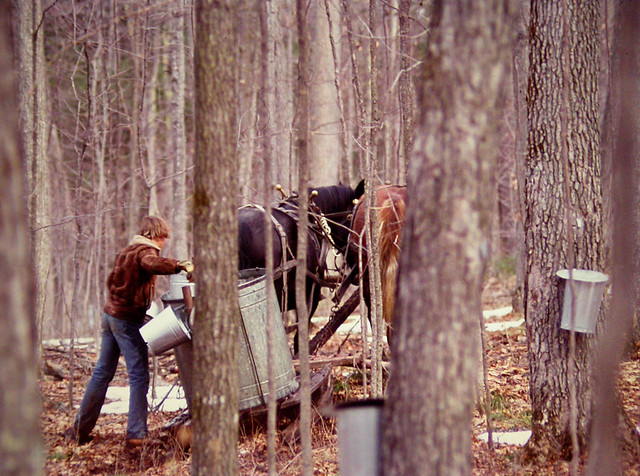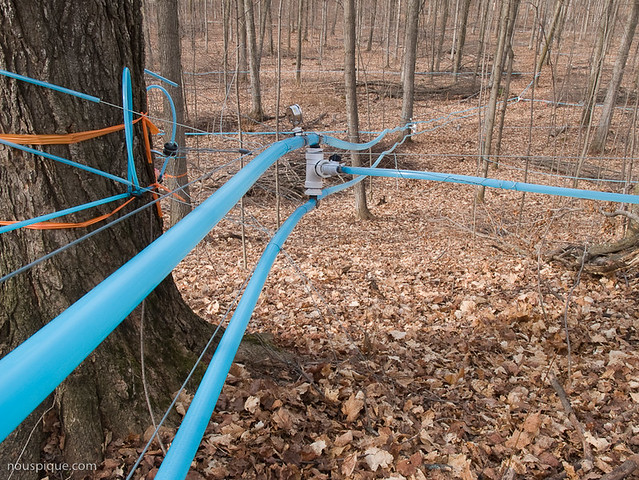Maple syrup is more than a sweet treat: to the sugarmakers of the Northeast, it’s a way of life. The tradition of maple sugaring has roots in indigenous culture and the sweet sap continues as a multi-million dollar industry today.
But this year’s warm winter and early spring made Vermont’s maple producers anxious. Some didn’t bother tapping trees at all because expectations were so low. In reality, yields were higher than last year, and the biggest difference was the timing: the 2016 sugaring season began and ended months earlier than it would have a generation ago. Still, sugarmakers are worried that their livelihood is at risk.

Maple at the Climate Crossroads
Climate change is shaking things up in the world of maple syrup. The industry once approached the woods as a machine that produces goods for human consumption. Sugarmakers would clear out understory to make forests easier to navigate. Next on the chopping block was every unproductive tree in the forest. If a tree was too old, too damaged, or (worse yet!) wasn’t a maple at all, it was likely to be logged out and sold as wood chips.
Now the outlook is shifting. This winter serves as a reminder to producers that climate change is already affecting us. Not only does it lead to unpredictable yields, but, according to Steve Hagenbusch of Vermont Audubon’s Bird-Friendly Maple Syrup Initiative, it brings other threats as well:
- Higher rates of intrusion by nonnative species. This could mean plants like Japanese barberry or honeysuckle, insects like the Eurasian longhorned beetle, or plant diseases.
- Changing herbivory patterns due to changing deer populations. Greater deer browsing on saplings means fewer young trees survive to populate the next generation.
- More frequent and violent winter storms can do structural damage to large trees.
Some producers suggest that there’s a clear solution to all these problems. Sustainable maple farming creates diverse systems that are resilient to environmental stress. Hagenbusch believes that climate change can be addressed using the same strategies that Audubon recommends for supporting bird habitat. Sustainable maple production seems to be a winning proposition for both sugarmakers and the ecosystems they manage.
Looking Forward: Technology over Tradition
However, here are two very different ideas about what it means to run a sustainable maple farm. One approach says that sugaring in the most traditional way—collecting syrup in buckets and managing forests entirely by hand—is the most ecologically sound. Keeping visible intervention in the forest to a minimum means the system thrives naturally.
Recently, however, some farmers have come to feel that technology isn’t the enemy. These new high-tech farms take advantage of modern techniques like vacuum pumping, extended networks of collection tubing, and reverse osmosis to maximize yield and quality while minimizing interference in the forest system

Matt Davis of Little Hogback Farm is a member of this new guard. His wife’s background in forestry informs their management practices, and they choose the most modern techniques. “People look at vacuum pumps like you’re sucking the life out of the tree,” Matt explains. “But in reality, it lets you put only one tap hole in a tree instead of three or four. That minimizes the damage to the trunk for the same total yield.”
The networks of collection tubes that spiderweb across these farms may look alien, but Matt says they allow farms to maintain a taller, thicker, more diverse understory. Not having to walk to every tree also means soils are less compacted and wildlife is less disturbed. The outcome is improved syrup collection and higher-quality habitat.
Standing Up to the Changing Climate
Not all of Vermont’s farmers fared the same this winter. Those who used vacuum pumping didn’t have to rely as heavily on the freeze-thaw cycle to move sap, and these modern methods meant high yields. While the technology is costly today, the changing climate could tilt the scales. When buckets dry up, vacuum tubes may still provide livelihoods for America’s sugarmakers—and the rich maple syrup we love.
Modern maple is a climate adaptation success story, and it can serve as a model for other industries. Experts maintain that technology is the best defense against the rising global temperatures. Innovations like alternative energy and new electric vehicles are critical in enduring the climate crisis, but moving away from fossil fuels won’t entirely erase global warming. Adaptation technologies might go against the grain, but they’re crucial to securing a sustainable future.

